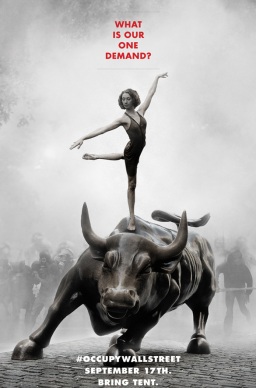
On September 17th, 2011, protesters occupied Zuccotti Park in New York City’s Wall Street financial district and renamed it Liberty Square. Setting up tents, working groups, and general assemblies, the Occupiers protested a variety of grievances including the reckless, destructive, and corrupt policies of Wall Street and the federal government’s bailout of banks, instead of people.
In a few weeks more than four hundred Occupy encampments had sprung up across the country. In municipal parks and in front of city halls, thousands of ordinary people voiced their discontent. They organized marches, rallies, acts of civil disobedience and daily demonstrations. They collectively moved their money from corporate banks and opened credit union accounts. They taught organizing skills and formed networks. They offered skill-building workshops and put out regular newspapers and online publications. They fundraised to “strike debt” with the Rolling Jubilee. At the height, a million US citizens were participating in the Occupy protests.
The Occupy slogan, “We are the 99%” inserted the concept of the 1% vs. the 99% into public consciousness, breaking through the void of silence about extreme inequality in the United States. Using slogans like, “You can’t stop an idea whose time has come” and the iconic ballerina on the Wall St. bull image, the Occupy protests about economic injustice and corporate-governmental collusion crashed through the media and daily life, into a level public awareness previously unseen.
Federal, state, and local security agencies colluded to evict the Occupiers who had persevered for months despite the onslaught of cold weather, snow, internal challenges, riot police, pepper spray, tear gas, rubber bullets, arrests, and more. In a coordinated crackdown, the occupations were broken up nationwide. Protesters were forced out of Zuccotti Park on November 15, 2011. People turned their focus to occupying banks, corporate headquarters, board meetings, foreclosed homes, and college and university campuses. Networks that had formed in the leaderless Occupy protests worked together to launch Occupy Sandy in response to the devastating hurricane, and evolved Rolling Jubilee into Strike Debt. As of April 2015, Rolling Jubilee had cleared nearly $32 million in debt. Occupy Medical in Eugene, OR continues to provide weekly medical care for hundreds of citizens.
In the documentary film, “Occupy Love”, Canadian activist Judy Rebick likened protests to waves upon the sand that – one after another – change the landscape of what’s possible in terms of social justice. Many new organizers and activists credit Occupy with moving them into action, and the current labor and economic justice movements stand on the shoulders of some of Occupy’s achievements, especially in cracking the concept of the 1% and the 99% into popular awareness.
Learn more here:
https://en.wikipedia.org/wiki/Occupy_Wall_Street
Photo Credit: By Source, Fair use, https://en.wikipedia.org/w/index.php?curid=33128550
______________________________________

Rivera Sun is a change-maker, a cultural creative, a protest novelist, and an advocate for nonviolence and social justice. She’s a love-based revolutionary and the author of The Dandelion Insurrection, The Way Between and ten other fiction, non-fiction and poetry books. Her essays and writings are syndicated by Peace Voice, and have appeared in over a hundred journals nationwide. Rivera Sun speaks and facilitates workshops in strategy for nonviolent change across the country and around the world. She connects the dots between the issues, shares solutionary ideas, and inspires people to step up to the challenge of being a part of the story of change in our times. www.riverasun.com